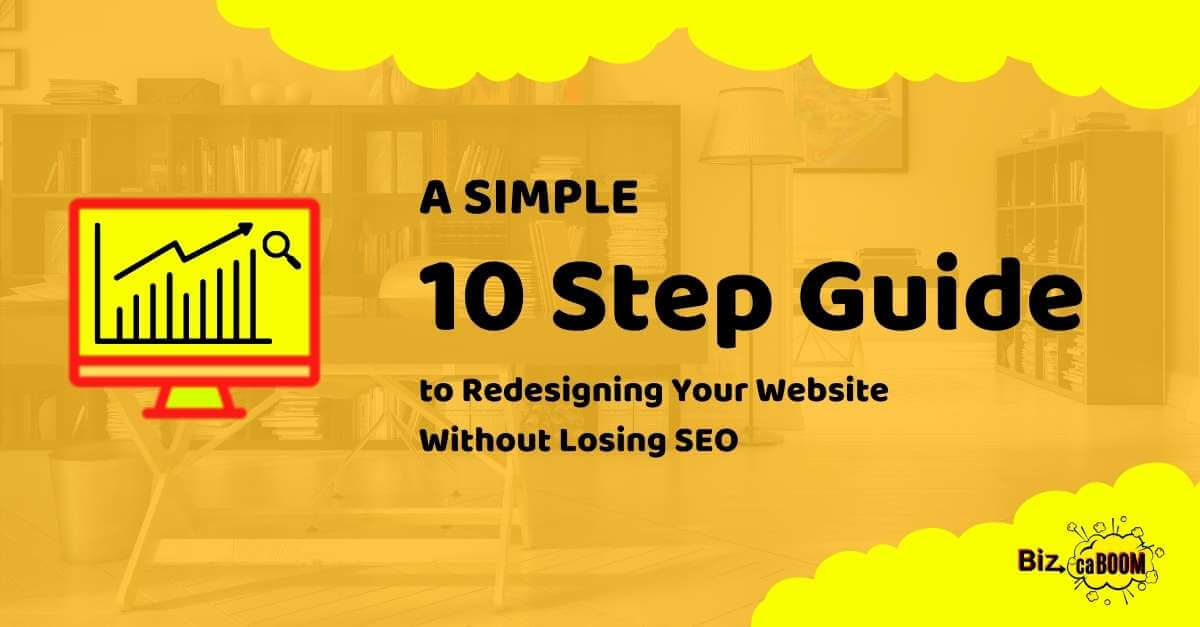
How to Rank Number One on Google
How to Rank NUMBER ONE (#1) on GOOGLE | BizcaBOOM The goal of getting to the top of Google’s number one search results is something

A website redesign is necessary from time to time (typically every 3 years) because it helps to give your site a new refreshing identity.
A big question that is asked in the web design community is how to redesign your website without losing SEO or any rankings on Google.
This can a tricky question to ask all in one paragraph, so we made a simple 10 step guide to redesigning your website without losing SEO.
In this guide you’ll learn exactly how what steps to take before, during, and after the website redesign process so not only will you sustain your SEO rankings, but even increase them over time:
The first step to redesigning your website without losing SEO is to take an inventory of your current website pages. This is a comprehensive overview of all the pages your website has.
For ease of use, the is a wide range of tools that you can use to take web page inventory. They include:

Before you even start thinking about the redesign of your website, you need to back it up first if you haven’t already.
This will help to ensure that all the vital content is still in place in case the redesign process doesn’t go as expected.
When creating a website backup, ensure that your database, theme files, as well as all the plugins are there. Just like taking an inventory, creating a backup is easy. in this case, it would be best to create a cloud backup.
The most ideal options include Dropbox: if you are using WordPress, then you might need a 3rd-party plugin to facilitate the backup process. Here are recommended WordPress plugins for backing up your website.
When creating a backup, go ahead and check your current SEO information. You need to collect all the SEO data to ensure that nothing gets lost during the redesign process.
Besides that, you will use this is a mark sheet to compare your update page and its previous state. You can easily check your latest SEO standings by using the Google Analytics tracking tool and then export the generated list for backup storage.
For you to effectively redesign a website without losing SEO, then you should map out the new design features either on a sheet of paper or on Google Sheets.
To do this, you have to document the critical information because this will serve as the appropriate guideline to determine the type of content you need to keep.
During this stage, you should use a plugin such as Yoast SEO to create a sitemap of your current page. Yoast SEO is highly effective in formatting XML files that have important URLs.
With the previously collected SEO stats by Google Analytics, you should have everything that you need. A combination of this information will help you determine the critical web pages that are responsible for generating the highest amount of traffic to your site.
Once you have noted this, then you should avoid making extensive changes to such pages. This is because a simple rewrite would cause a significant change, leading to the loss of SEO.
Take note of the primary keywords on each page and ensure that you still continue to use them in headings, meta descriptions, and titles.
On the other hand, pages that generate lesser traffic should definitely be changed in some way, with new content or a better design.
In some instances, you might be forced to completely delete them. However, if you delete a page, ensure that you use a 301 redirect. This will help to ensure that search engines and visitors are rerouted to the page’s new replacement on the new website.
When redesigning your website, you don’t want to edit your live website, especially if it’s getting traffic. Similar to creating a draft for an email or letter, you must create your new website on a staging platform that is not attached to your current website.
Staging the new site involves you correcting all the errors, fixing some of the broken links, in addition to optimizing the custom code.
You need to do all these and ensure that they are functional.
To stage the new site, you have to temporarily launch the redesigned website using a separate staging server. It should be in a protected environment to prevent visitors from accessing it.
At this point, you should carry out the test process by verifying if all the pages are set up correctly. Check if all the internal links are functional.
This is a critical testing phase because search engines normally use internal links to evaluate and rank web pages in search results.
Note: does your website SEO redesign involve changing URLs? If so, then you should consider verifying if the internal links are updated as well. There are several plugins that you can use to determine this. It’s worth noting that most people usually access websites using mobile devices.
While carrying out the testing process, ensure that you check if the redesigned website is mobile-friendly. During the redesign process, your old website has to remain active since you will be using it as the reference point.
While redesigning your website, ensure that you keep the same website content to ensure that the SEO contents remain intact. The only time you should make drastic changes to the content and structure of your website in a website redesign is when:
If you have valuable content, then make sure that you don’t remove or add any pages or change the pre-existing URLs. But if it’s necessary, then you can still make use of the 301 directs. However, implementing the redirects can be a bit complicated. Learn more about 301 redirects and you can use them to keep your SEO rankings.
Of course, you want to effectively redesign your website without losing SEO and that’s why you should define the link redirects to ensure that nothing is lost.
Whether you have carried out minor or significant changes, it’s important that the new updates are documented.
Documenting any redirects in Google Sheets or any other place is something you should do in order to keep the website redesign process simple, because redirects can get very complicated and will make it harder for you to maintain your SEO if you don’t redirect old pages to newer pages on your website.
The goal is to ensure that your visitors don’t experience the 404 error when they click your website links.
Note: with your old website page still active, compare the sitemap of the latest site to the former. Take into account every URL so that in case you delete or change a URL, to learn more about sitemaps visit this article from Google Search Central.
You have carried out a comprehensive test analysis and ensured that everything is working as expected?
Well, it’s now time to launch your newly redesigned website. This is the heaviest part of the whole redesign process and you can’t completely do it by yourself, especially if you are not a developer.
As a result, you might have to seek the services of experienced developers. However, your work at this point would be to verify all the details of the website to ensure that the website is redesigned and all the vital SEO components are retained.
When launching your redesigned website, make sure that you make create a schedule for it. The best time to do this is when you expect the least traffic. This way, if something is malfunctioning or there is a delay in launching the website, then only a few people will experience the problem.
It’s also important that you carry out tests when you go live. You have to double-check to ensure that everything is working properly before hand.
Post-launch verification activities should involve:
The purpose of the redesign is to improve your website performance, and for it to further accelerate the growth of your business. Therefore, everything should be meticulously handled.
If you have verified that everything is set up as you want, then you should get proactive in letting Google know that your new site needs to be crawled. But how do you do this? Well, open the Google Search Console and then enter your site’s URL under this search engine’s URL Prefix.
Wait for Google to check the URL and then click the “Request Indexing” button. Indexing allows Google to understand what your page is all about. It will also catalog the contents of your website page including images and videos that are embedded on the web pages.
This is crucial for SEO search engine results.
Note: It’s important that you manually index your site yourself because it makes the whole process easier and almost instant. In case you wait for search engines to find your site, then you must wait for a couple of days.
If the redesign of your website resulted in significant changes, there might be a chance that your rankings on Google may vary depending on the target keyword.
But this shouldn’t be a cause of panic, especially if you have refined your website, retained the SEO, and made it more mobile-friendly.
If you start to see your SEO rankings drop right after the redesign of your website, then this is most likely because Google or the other search engines have not reevaluated your new site.
They have to reassess the new content or structure since these features play a huge role in determining the SEO value that your pages utilize.
Give your website a couple of weeks for Google to fully evaluate your website. If you have followed this guide on how to redesign your website without losing rankings, then you should actually see an increase of SEO rankings after a few weeks.
For starters, robots.txt is a file that’s designed to tell the search engine crawlers which type of pages or files they can’t or can request from your website.
This file is important because it helps to reduce the chances of your site getting overloaded with requests, which can damage your website’s SEO.
Which is why you need to check your robots.txt file to see if it’s configured correctly.
To check if your robots file, go ahead and use the robots.txt tester option that’s located under the crawl option in Google Search Console. Overall, it’s important to use this file because it’s effective in allowing or denying access to search engines to certain pages of the website or the whole website.
Note that sitemaps are important for websites in addition to search engines. Besides that, they are crucial in providing metadata, for instance, how often each website page gets updated.
For search engines like Google, they make it easier for them to get crucial information regarding the structure of your web pages and website in general.
Overall, by simply submitting your XML sitemap to the Google Search Console, you can automatically guarantee SEO rankings for your website. But how do you go about this?
Follow this video tutorial here on how to submit an XML sitemap to Google.
This will help the search engines to quickly and effectively index your newly redesigned website.
The above-mentioned elements are critical on how to redesign a website without losing SEO. But while you are it, you should make sure that you monitor your newly redesigned website’s rankings.
One of the best tools to use for website monitoring is SEMrush, a ranking tool.
Besides that, you can also do the monitoring process manually by simply keeping a record of your site’s ranking positions based on different keywords.
The goal of monitoring is to ensure that you notice any significant changes, whether negative or positive. This is important for you in designing corrective actions or improves the positive ones.
While monitoring your SEO and website rankings on Google and other search engines, keep in mind that your rankings might experience massive fluctuations in the first few days after activation.
If this happens to you, remember, DON’T PANIC.
That means that you shouldn’t be sad if there is a big drop or get over-excited if there is a massive increase. It will take a couple of weeks for the ranking to finally stabilize and if things are bad at this point, that’s when you should start thinking about the corrective measures that you should implement.
Generally, significant negative changes are caused by changing the existing content dramatically or by not following the right SEO and web design strategies in the first place.
Website redesign is a crucial and detailed process that’s critical in giving your site a fresh outlook.
Note that the internet world is quite dynamic and with the high level of competition, you need to have a refreshing digital identity.
However, if the overhaul is significant, then your SEO and search engine rankings may end up getting affected.
However, if you implement the above-reviewed 10 steps, then your SEO won’t be impacted negatively. Make sure that you understand what’s in your current website and create a backup before you start the redesign process.

If you ever need a helping hand in getting your business more profits with digital marketing, contact BizcaBOOM, a Woodlands Web Design Company, to get your website up and making your business more money.
We specialize in high end website design and SEO and can help you exponentially grow your business! Give us a call and let’s chat!
Now that you have learned a simple 10 step guide to redesigning your website without losing SEO, why not share this post with your friends?
Spread the word out so we can continue to give you content on how to BOOM your business and establish dominance on the internet with digital marketing!
Recent Articles:

How to Rank NUMBER ONE (#1) on GOOGLE | BizcaBOOM The goal of getting to the top of Google’s number one search results is something

How to Choose the Right Keywords for SEO Purposes | BizcaBOOM One of the most critical aspects of good search engine optimization is choosing the

Is SEO Better than Google Ads? SEO vs Google Ads Many businesses use marketing techniques such as search engine optimization (SEO) and Google Ads to

How to Rank NUMBER ONE (#1) on GOOGLE | BizcaBOOM The goal of getting to the top of Google’s number one search results is something

How to Choose the Right Keywords for SEO Purposes | BizcaBOOM One of the most critical aspects of good search engine optimization is choosing the

Is SEO Better than Google Ads? SEO vs Google Ads Many businesses use marketing techniques such as search engine optimization (SEO) and Google Ads to
Tell us about your company:

Speak with a Digital Marketing Expert:
BizcaBOOM is a web design and SEO company in Houston & The Woodlands, TX. We specialize in high-ROI SEO services and web design for small businesses and home service companies. Feel free to give us a call at (832) 605-0924 and let’s help you get more leads, traffic, and exposure!